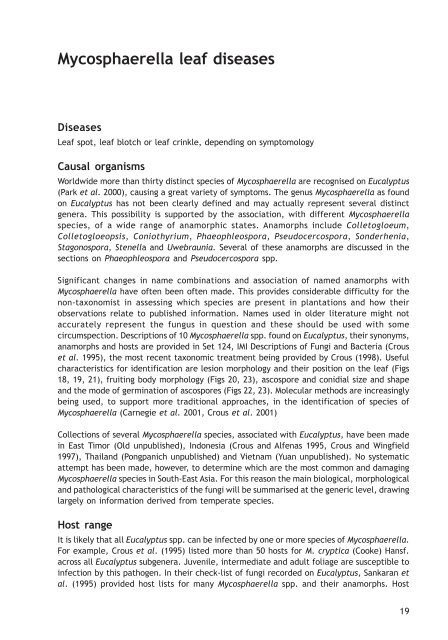A manual of diseases of eucalyptus in South-East Asia - Center for ...
A manual of diseases of eucalyptus in South-East Asia - Center for ...
A manual of diseases of eucalyptus in South-East Asia - Center for ...
Create successful ePaper yourself
Turn your PDF publications into a flip-book with our unique Google optimized e-Paper software.
Mycosphaerella leaf <strong>diseases</strong><br />
Diseases<br />
Leaf spot, leaf blotch or leaf cr<strong>in</strong>kle, depend<strong>in</strong>g on symptomology<br />
Causal organisms<br />
Worldwide more than thirty dist<strong>in</strong>ct species <strong>of</strong> Mycosphaerella are recognised on Eucalyptus<br />
(Park et al. 2000), caus<strong>in</strong>g a great variety <strong>of</strong> symptoms. The genus Mycosphaerella as found<br />
on Eucalyptus has not been clearly def<strong>in</strong>ed and may actually represent several dist<strong>in</strong>ct<br />
genera. This possibility is supported by the association, with different Mycosphaerella<br />
species, <strong>of</strong> a wide range <strong>of</strong> anamorphic states. Anamorphs <strong>in</strong>clude Colletogloeum,<br />
Colletogloeopsis, Coniothyrium, Phaeophleospora, Pseudocercospora, Sonderhenia,<br />
Stagonospora, Stenella and Uwebraunia. Several <strong>of</strong> these anamorphs are discussed <strong>in</strong> the<br />
sections on Phaeophleospora and Pseudocercospora spp.<br />
Significant changes <strong>in</strong> name comb<strong>in</strong>ations and association <strong>of</strong> named anamorphs with<br />
Mycosphaerella have <strong>of</strong>ten been <strong>of</strong>ten made. This provides considerable difficulty <strong>for</strong> the<br />
non-taxonomist <strong>in</strong> assess<strong>in</strong>g which species are present <strong>in</strong> plantations and how their<br />
observations relate to published <strong>in</strong><strong>for</strong>mation. Names used <strong>in</strong> older literature might not<br />
accurately represent the fungus <strong>in</strong> question and these should be used with some<br />
circumspection. Descriptions <strong>of</strong> 10 Mycosphaerella spp. found on Eucalyptus, their synonyms,<br />
anamorphs and hosts are provided <strong>in</strong> Set 124, IMI Descriptions <strong>of</strong> Fungi and Bacteria (Crous<br />
et al. 1995), the most recent taxonomic treatment be<strong>in</strong>g provided by Crous (1998). Useful<br />
characteristics <strong>for</strong> identification are lesion morphology and their position on the leaf (Figs<br />
18, 19, 21), fruit<strong>in</strong>g body morphology (Figs 20, 23), ascospore and conidial size and shape<br />
and the mode <strong>of</strong> germ<strong>in</strong>ation <strong>of</strong> ascospores (Figs 22, 23). Molecular methods are <strong>in</strong>creas<strong>in</strong>gly<br />
be<strong>in</strong>g used, to support more traditional approaches, <strong>in</strong> the identification <strong>of</strong> species <strong>of</strong><br />
Mycosphaerella (Carnegie et al. 2001, Crous et al. 2001)<br />
Collections <strong>of</strong> several Mycosphaerella species, associated with Eucalyptus, have been made<br />
<strong>in</strong> <strong>East</strong> Timor (Old unpublished), Indonesia (Crous and Alfenas 1995, Crous and W<strong>in</strong>gfield<br />
1997), Thailand (Pongpanich unpublished) and Vietnam (Yuan unpublished). No systematic<br />
attempt has been made, however, to determ<strong>in</strong>e which are the most common and damag<strong>in</strong>g<br />
Mycosphaerella species <strong>in</strong> <strong>South</strong>-<strong>East</strong> <strong>Asia</strong>. For this reason the ma<strong>in</strong> biological, morphological<br />
and pathological characteristics <strong>of</strong> the fungi will be summarised at the generic level, draw<strong>in</strong>g<br />
largely on <strong>in</strong><strong>for</strong>mation derived from temperate species.<br />
Host range<br />
It is likely that all Eucalyptus spp. can be <strong>in</strong>fected by one or more species <strong>of</strong> Mycosphaerella.<br />
For example, Crous et al. (1995) listed more than 50 hosts <strong>for</strong> M. cryptica (Cooke) Hansf.<br />
across all Eucalyptus subgenera. Juvenile, <strong>in</strong>termediate and adult foliage are susceptible to<br />
<strong>in</strong>fection by this pathogen. In their check-list <strong>of</strong> fungi recorded on Eucalyptus, Sankaran et<br />
al. (1995) provided host lists <strong>for</strong> many Mycosphaerella spp. and their anamorphs. Host<br />
19

















